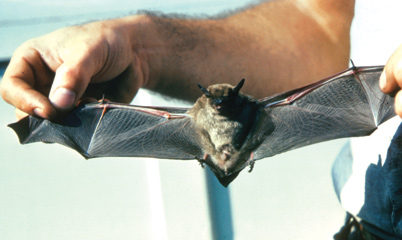Nature’s Bug Zappers
By Kathy Reshetiloff
Bats.
Just the word makes some people cringe. I remember, as a kid,
ducking from swooping bats in the evening, believing they would
attack me or get caught in my hair. They’re probably one
of the most misunderstood and maligned animals. Despite what movies,
television and literature would have you believe, bats are not
terrors of the night.
 Bats
are incredibly important not only to our natural world but to
our economy as well. As primary predators of night-flying insects,
bats help to control many of our most annoying pests. A single
little brown bat can catch 1,200 mosquito-sized insects in an
hour. Big brown bats consume costly crop pests, including cucumber
beetles, June beetles, leafhoppers, cutworm moths and corn earworm
moths. Bats
are incredibly important not only to our natural world but to
our economy as well. As primary predators of night-flying insects,
bats help to control many of our most annoying pests. A single
little brown bat can catch 1,200 mosquito-sized insects in an
hour. Big brown bats consume costly crop pests, including cucumber
beetles, June beetles, leafhoppers, cutworm moths and corn earworm
moths.
Bats in tropical areas feed on nectar, pollen and fruit. These
bats, like bees, butterflies and hummingbirds, are crucial to
the pollination of economically valuable plants. Some tropical
bats even feed on fish or frogs, swooping over lakes searching
for prey in the dark of night. The infamous vampire bat of Mexico
and South America is the only species to feed on blood, mainly
that of cattle or other domestic animals.
Bats are the only flying mammal. The fingers in a bat’s
hand are the same as a person’s except the bat’s bones
are elongated and connected by skin to form a wing. Like all mammals,
bats have hair and their young are born live and feed on milk.
We often associate bats with rabies. Like all mammals, bats can
contract the disease but less than one percent of bats carry it.
Bats with rabies are not very aggressive and die quickly. And,
like most wild animals, bats will only try to bite when handled.
Bats are not blind. Those that do hunt in the dark have developed
a system to help detect objects. These bats produce sounds at
high frequencies. By listening to the echoes of these sounds,
bats are able to discern objects. This is known as echolocation.
Using the reflected sounds, they form pictures in their brains
just like we do by interpreting reflected light with our eyes.
While tropical bats are active year ’round, those in temperate
regions either hibernate or migrate during the winter. Many bats
hibernate in caves in winter and move to trees and buildings during
summer. Some bats reside in caves all year but have different
summer and winter roosts. Bats often use the same hibernation
sites and summer roosts from year to year. During hibernation,
a bat’s metabolism slows so that it uses very little of
its stored fat. Heart rates slow drastically, and body temperatures
drop dramatically. To control body temperature, bats often roost
together in great numbers.
Disturbance by people is a major cause of the decline of many
bat species. Bats are also threatened by loss of feeding or roosting
habitat, usually wooded areas near water sources. Disturbing a
maternity colony can cause mothers to drop their young or move
them to a less suitable site. Disturbance during hibernation wakes
bats, causing them to burn the precious fat reserves they have
stored for the winter. Even responsible cave explorers can inadvertently
disturb bats at critical times of the year.
Two endangered species of bats live in the Chesapeake Bay watershed,
Indiana bats and Virginia big-eared bats. During summer, Indiana
bats roost under tree bark along wooded streams. Females usually
bear only one young in June. During the winter, Indiana bats hibernate
in caves in dense clusters, averaging 300 bats per square foot.
Because they mass together in winter, disturbance to one wintering
cave can lead to high fatalities. The loss of streamside summer
habitat stresses the population even more.
The Virginia big-eared bat, another endangered species, occupies
caves during both the summer and winter. They too bear only one
pup each year, are very intolerant of people, and suffer many
of the same threats as Indiana bats.
Protecting these habitats is crucial to saving these species.
Wooded streamside areas need to be protected for roosting. Preventing
people from entering maternity caves and winter hibernation caves
is critical. Since bats use these caves seasonally, entry may
only have to be restricted during certain months. A cave entrance
can be gated or fenced, preventing people from entering while
allowing bats to fly in and out.
For more information about bats, bat houses and ways to protect
bats, contact Bat Conservation International, www.batcon.org,
P.O. Box 162603, Austin, Texas, 78716, or phone 800-538-2287.
Bat Facts:
• There are roughly 1,100 different species of bats in the
world, living on every continent except Antarctica.
• A colony of 150 big brown bats can protect local farmers
from up to 33 million rootworms each summer.
• The 20 million Mexican free-tail bats from Bracken Cave,
Texas, eat approximately 200 tons of insects nightly.
• In the wild, important foods, like bananas, mangoes, cashews,
dates and figs rely on bats for pollination and seed dispersal.
• Nectar-feeding bats are the primary pollinators of giant
cacti, including the famous organ pipe and saguaro cacti of the
American Southwest.
• Bats occasionally fly into homes and other buildings.
They will usually leave on their own if a window or door to the
outside is left open while others leading to the rest of the building
remain closed.
After 10 years as a biologist, Kathy Reshetiloff now writes on a variety of
topics for the U.S. Fish and Wildlife Service, U.S. Department of the Interior.
|
Back
|

